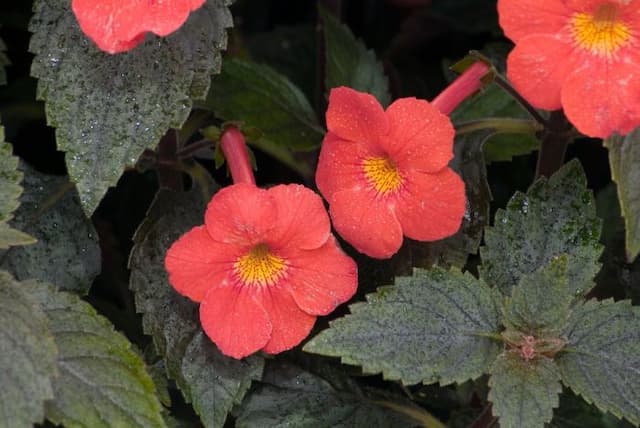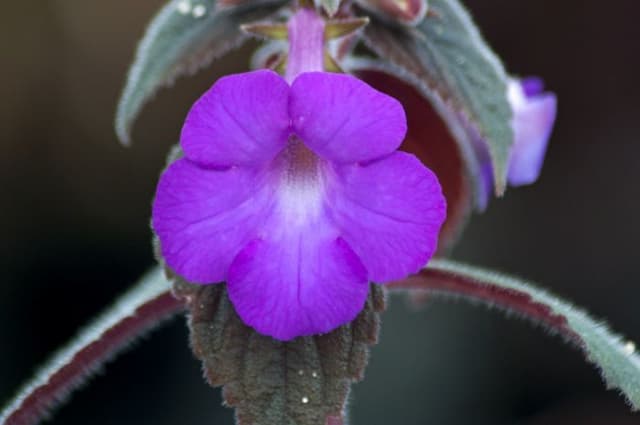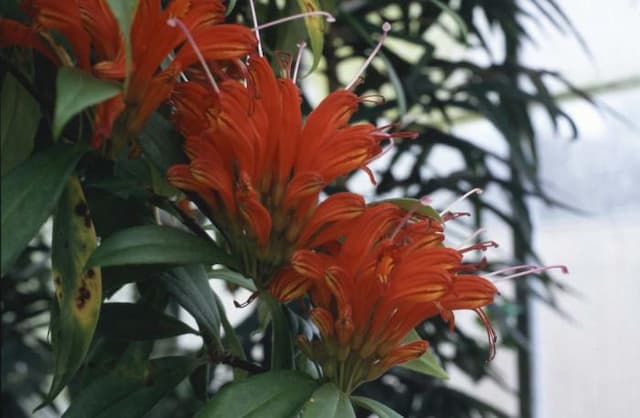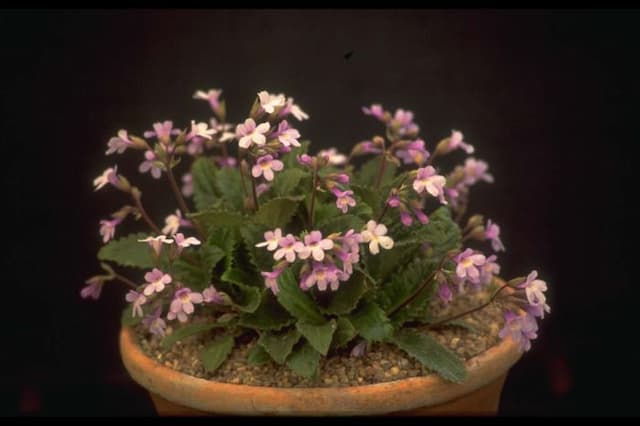False African Violet Streptocarpus saxorum

ABOUT
The plant commonly known as false African violet features soft, deep green leaves with a slightly fuzzy texture, giving them a lush and inviting appearance. These leaves grow in a rosette pattern, emerging in a cluster from the base of the plant, elegantly arching outwards. It is the charming blooms that truly captivate onlookers; they are delicate and trumpet-shaped, often displaying a lovely shade of pale blue to purple, with some varieties boasting white or soft pink flowers. Each blossom is complemented by a slender, protruding stamen in the center. The foliage and flowers together create a delicate, woodsy aesthetic, as the blooms appear to hover above the leafy base, creating a delightful contrast. This plant tends to have a sprawling habit, with its soft stems occasionally giving it a slightly wild, naturalistic look, which contributes to its ornamental charm ideal for indoor settings.
About this plant
 Names
NamesFamily
Gesneriaceae.
Synonyms
Cape Primrose, False African Violet, Streptocarpella.
Common names
Streptocarpus saxorum
 Toxicity
ToxicityTo humans
Cape primrose (Streptocarpus saxorum) is generally considered non-toxic to humans. There are no well-known toxic effects from ingesting this plant or handling it. However, it is always advisable to avoid ingesting plants not meant for consumption, as individual sensitivities or allergic reactions can occur.
To pets
Cape primrose is also typically non-toxic to cats, dogs, and other household pets. However, it is important to prevent pets from eating plants, as they can cause gastrointestinal upset or an unexpected allergic reaction even if the plant is not considered poisonous.
 Characteristics
CharacteristicsLife cycle
Perennials
Foliage type
Evergreen
Color of leaves
Green
Flower color
Blue
Height
1 foot (30 centimeters)
Spread
1 foot (30 centimeters)
Plant type
Herb
Hardiness zones
10
Native area
Tanzania
Benefits
 General Benefits
General Benefits- Low Maintenance: Streptocarpus saxorum, commonly known as false African violet, is an easy-to-care-for houseplant that does not require frequent watering or complex care routines.
- Aesthetic Appeal: With its delicate foliage and attractive flowers, the false African violet brings a touch of beauty and vibrancy to indoor spaces.
- Long Blooming Period: This plant often has a prolonged flowering season, providing color and interest for much of the year.
- Compact Size: Its relatively small size makes it an excellent choice for window sills, desks, and other limited spaces.
- Adaptability: The false African violet adapts well to a range of indoor environments, from low to bright indirect light conditions.
- Breeding Possibilities: It can be used to breed with other Streptocarpus species to create hybrids with various desirable characteristics.
- Propagation Ease: The plant is easily propagated from leaf cuttings, making it simple to multiply and share with others.
- Non-Toxicity: Streptocarpus saxorum is non-toxic to pets and humans, making it safe for a household with animals and children.
 Medical Properties
Medical PropertiesThis plant is not used for medical purposes.
 Air-purifying Qualities
Air-purifying QualitiesThis plant is not specifically known for air purifying qualities.
 Other Uses
Other Uses- Miniature Landscapes: Streptocarpus saxorum can be used in creating miniature fairy gardens or terrarium landscapes due to its small size and attractive foliage.
- Photography Prop: Its delicate flowers can serve as a beautiful and natural backdrop for macro photography and botanical illustration.
- Educational Tool: Schools and educational programs can use the plant to teach children about plant growth, pollination, and the care of living organisms.
- Crafts: The flowers of Streptocarpus saxorum can be used in dried flower crafts such as making bookmarks, greeting cards, or pressed flower art.
- Aquariums: While not an aquatic plant, Streptocarpus saxorum could be used decoratively near aquariums, providing a complementary visual aesthetic without being submerged.
- Home Office Decor: The plant can bring a touch of greenery to home office spaces, making the work environment more relaxed and soothing.
- Culinary Presentation: Though not edible, the flowers could be used temporarily as an organic garnish for plating and presentation of culinary dishes.
- Textile Inspiration: The varied and vibrant colors of Streptocarpus saxorum can inspire patterns and designs in textile and fashion design.
- Theatre and Film: The plant could be used in stage design or film sets to evoke a homely or garden atmosphere without the need for large or high-maintenance plants.
- Study subject: Streptocarpus saxorum's growth habits and adaptability make it a suitable subject for botany students and hobbyists interested in plant propagation and hybridization.
Interesting Facts
 Feng Shui
Feng ShuiThe Cape Primrose is not used in Feng Shui practice.
 Zodiac Sign Compitability
Zodiac Sign CompitabilityThe Cape Primrose is not used in astrology practice.
 Plant Symbolism
Plant Symbolism- Resilience: Streptocarpus saxorum, commonly known as Cape primrose, often symbolizes resilience because it can flourish in challenging environments and recover well from neglect.
- Enduring Love: With its long blooming season and hearty disposition, Cape primrose can represent enduring or long-lasting love.
- Adaptability: Due to its ability to adapt to various indoor conditions, the Cape primrose is often associated with adaptability in the face of change.
- Hope and Renewal: The consistent flowering of the Cape primrose, sometimes even in low light, makes it a symbol of hope and the renewal of life.
 Water
WaterFor the Cape Primrose, water the plant thoroughly when the top inch of soil feels dry to the touch. Depending on the humidity and temperature of the environment, this may mean watering approximately once a week. Always allow excess water to drain away, as standing water can cause root rot. A general rule of thumb is to provide about one cup (or 8 ounces) of water for a 6-inch pot every 7 to 10 days, adjusting for climate and indoor conditions. Water less often in winter when the plant is not actively growing.
 Light
LightThe Cape Primrose prefers bright, indirect light. A spot near an east-facing or north-facing window is ideal, as direct sunlight can burn the leaves. If only a south or west-facing window is available, use a sheer curtain to filter the light. A well-lit room without any direct sun exposure would also suit this plant well.
 Temperature
TemperatureThe Cape Primrose thrives in temperatures between 60°F and 75°F. It can tolerate a minimum of 50°F and a maximum of 80°F without damage. However, maintaining a temperature in the ideal range will promote healthy growth and flowering.
 Pruning
PruningPrune the Cape Primrose to maintain a compact shape and encourage bushier growth. Trim back leggy stems and remove any dead or yellowing leaves regularly. The best time to prune is in late winter or early spring, just before the onset of the growing season. Pruning can be done every few months or as needed to remove unhealthy foliage.
 Cleaning
CleaningAs needed
 Soil
SoilThe Cape primrose prefers a light, well-draining soil mix, often coupled with perlite or pumice to improve aeration. An ideal pH for this soil would be slightly acidic to neutral, ranging from 6.0 to 7.0.
 Repotting
RepottingCape primrose should generally be repotted every 1 to 2 years to refresh the soil and accommodate root growth, preferably in spring or summer.
 Humidity & Misting
Humidity & MistingCape primrose thrives in moderate to high humidity levels, ideally between 50% to 60%, avoiding overly dry or excessively moist environments.
 Suitable locations
Suitable locationsIndoor
Place in bright, indirect light and keep soil lightly moist for best growth.
Outdoor
Provide dappled shade, and shelter from harsh conditions.
Hardiness zone
10-11 USDA
 Life cycle
Life cycleCape primrose (Streptocarpus saxorum) begins its life as a small seed, which when sown in a well-draining soil mix and given appropriate warmth and moisture, will germinate. The seedlings slowly emerge, developing their first set of true leaves after the initial embryonic leaves or cotyledons. As they mature into juvenile plants, they form a rosette of leaves and continue to grow, requiring indirect light, regular watering, and higher humidity. With proper care, the plant eventually reaches the flowering stage, where it produces delicate, tubular flowers, often in shades of blue, purple, or white. Once pollinated, either by insects or self-pollination, these flowers produce seed pods that can further disperse seeds, perpetuating the species. In ideal conditions, Cape primrose can continue to thrive and rebloom for several years when its growing requirements are consistently met.
 Propogation
PropogationPropogation time
Spring to Summer
Propogation: The Streptocarpus saxorum, commonly known as false African violet or Cape primrose, is typically propagated during the spring and summer months when the plant is actively growing. The most popular method of propagation is through leaf cuttings. A healthy, mature leaf is selected and cut into segments, ensuring that each segment contains a portion of a vein. These segments are then laid on the surface of a well-draining potting mix and gently pressed down. It is important to maintain high humidity, steady warmth, and filtered light to encourage rooting. Rooting typically occurs within a few weeks, after which each segment will develop its own shoots and can be potted individually once the roots are well established.









